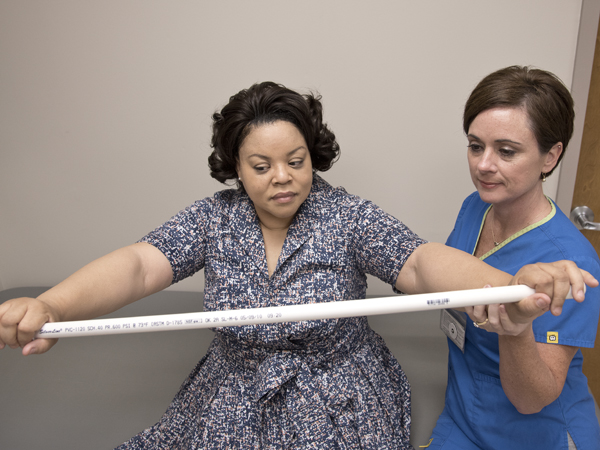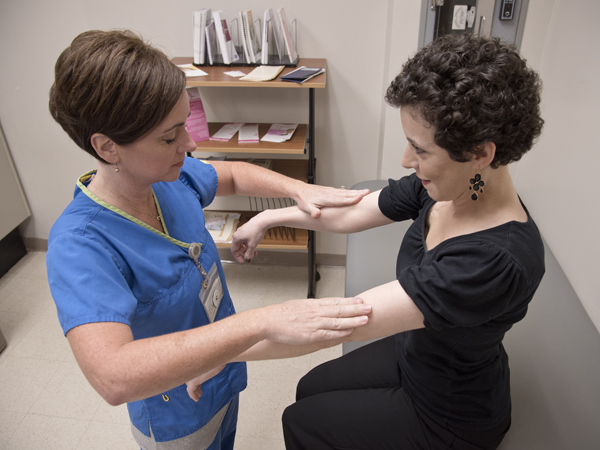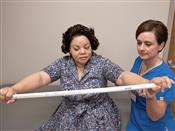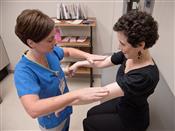New physical therapy program helps improve breast cancer patients’ outcomes

Published in News Stories on October 26, 2015
There are currently more than 2.8 million breast cancer survivors in the U.S., according to the American Cancer Society. They include both women and men, and their survival is due in part to today's more effective treatment options and diagnostic tools for early detection.
As many who have experienced cancer know, surviving is not the end of the story.
Cancer treatment, while life-saving, can come with complications and lasting side effects. Some of the problems breast cancer survivors may face include long-term pain, axillary fascia issues, scar mobility, lymphedema and issues with strength and range of motion.
Mischelle Vining, PT, DPT, a physical therapist at the University Physicians Grants Ferry location, has designed a program to help catch complications before they become severe. Her program is now a part of the multidisciplinary breast cancer clinic held on Thursdays at the University of Mississippi Medical Center Cancer Institute in the Jackson Medical Mall.
“Pre-habilitation is fast becoming the standard of care for breast cancer patients throughout our country. It is a part of survivorship,” said Vining. “Not only do we want our patients to be cured from cancer, but we also want them to have full use of their upper extremities during and after treatment. We are looking at the person as a whole.”
The idea came about when Becky Weber, assistant director of rehabilitation services at the University Physicians Pavilion, approached Vining to say that there may be an opportunity to work with breast cancer patients.
“We noticed patients receiving therapy at the Pavilion who had been through breast cancer treatment presenting with shoulder and scar issues,” said Vining. “We saw a need to start a program to prevent these complications from worsening.”
The program begins with the diagnosis of breast cancer. The patient is seen by Vining prior to surgery so that baseline measurements of strength, range of motion and arm girth can be recorded. She also educates the patients and provides a written program for shoulder range of motion that patients follow at home after surgery. Four more visits are scheduled for the year following surgery, to ensure that patients don't develop impairments in their arms and shoulders later in the healing process.
If a patient develops complications, they are brought in for therapy weekly to address the problem before it becomes a more serious issue.
La'Chelle Rush, 46, from Clinton, was diagnosed with ductal carcinoma in situ and elected to have a bilateral mastectomy.
“They were able to catch it really early,” said Rush. “I didn't have any family history, I had no signs or symptoms. If it hadn't been for my yearly mammogram, they would not have found it.”
Before surgery, Rush met with Vining for her baseline measurements, at the request of her surgeon, Dr. Shawn McKinney.
“Initially, I didn't understand the correlation between the two,” said Rush. “I went to see Mischelle and I thought, 'I don't know why I'm here, but she is so kind and caring.'
“She showed me how to do some exercises and stretches before my surgery. After my surgery, I could have kissed her. If I hadn't known what stretches and exercises to do after surgery, my recovery would have been much more difficult.”
A little more than a month after surgery, Rush began to experience pain in her arm.
“At first I thought, 'Oh, great! I have carpal tunnel,'” said Rush. She feared surgery might be necessary.
McKinney referred Rush to physical therapy for the pain.
“Mischelle saw me and said, 'I know exactly what this is. It's your fascia,'” said Rush. “On my first visit, I was in so much pain that I was in tears. I told her that if this doesn't work, I'm going to need a prescription fast. She said, 'no, this is going to work,' and it did.”
Rush received therapy every Thursday until she was pain free. She was also provided with exercises to do at home. She'll continue to be evaluated every 3-6 months for complications that may occur in the future.

Patients who undergo treatment for breast cancer can suffer from loss of strength and range of motion. Vining, left, performs manual muscle testing reassessment of shoulder flexion for patient Sara Harvey Roberts.
Dr. Barbara Craft, director of the University Cancer Care breast team, said that the initial visit to physical therapy prepares patients for what to expect before and after surgery.
“I think it's good continuity of care for our patients,” said Craft. “Seeing Mischelle before surgery helps patients with fear. It helps prepare them mentally and physically for surgery. It is definitely beneficial.”
Sara Harvey Roberts, 37, of Ridgeland, saw Craft for Stage IIB breast cancer in September of 2014. Her treatment consisted of chemotherapy, surgery and radiation. Roberts was warned that she might be more likely to have lymphedema, a swelling in the arms caused by poor fluid drainage as a result of the removal of lymph nodes.
“I knew that if I did have lymphedema I was not going to have to go through it on my own,” said Roberts. “Mischelle is readily available to answer any questions.
“Honestly, I am so thankful that I did my treatment at UMMC. I feel like it is a collaborative effort with all the physicians. They are all working together to be sure they are looking at every possible aspect so that I am treated well and, hopefully, don't have a recurrence.”
Photos
 | High Resolution Medium Resolution Low Resolution |
 | High Resolution Medium Resolution Low Resolution |


